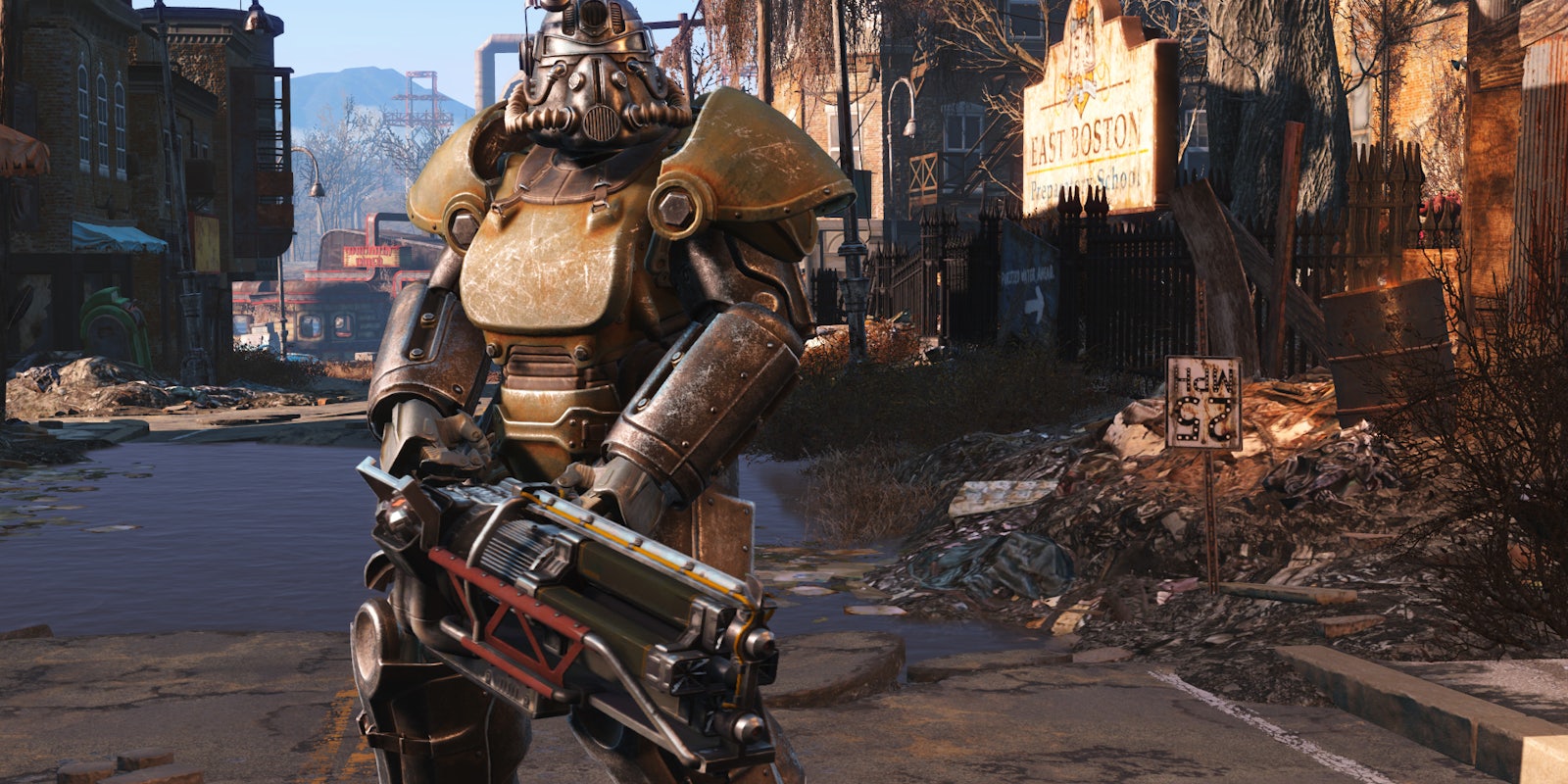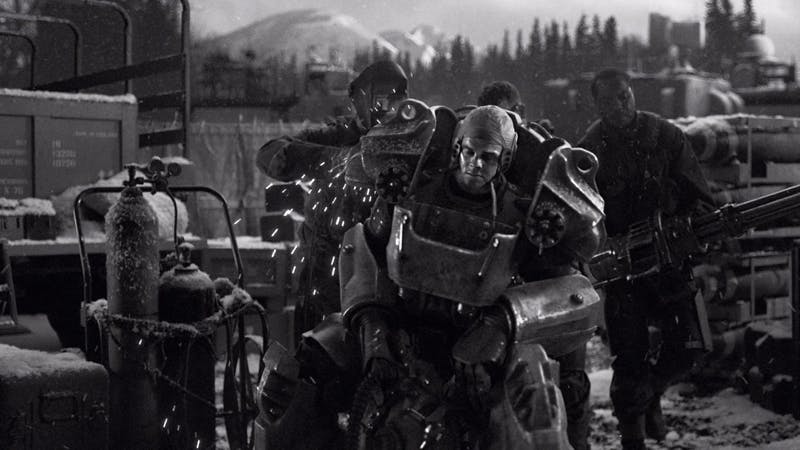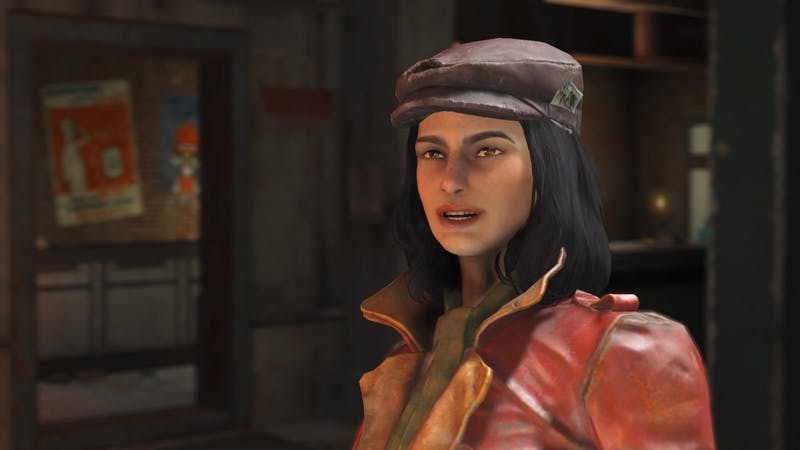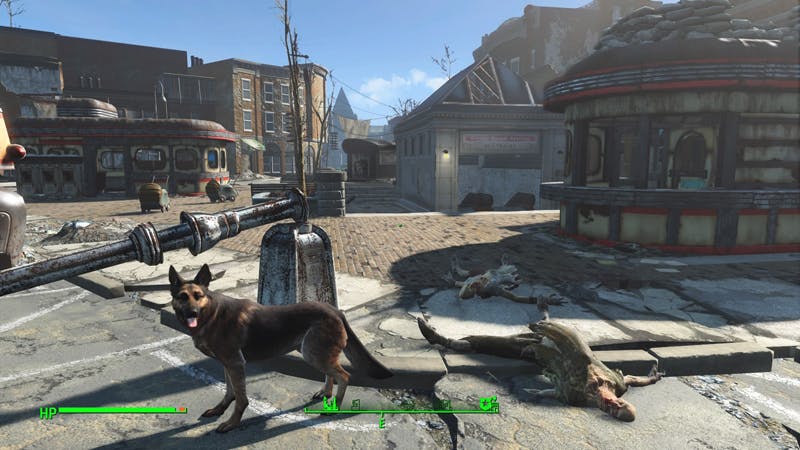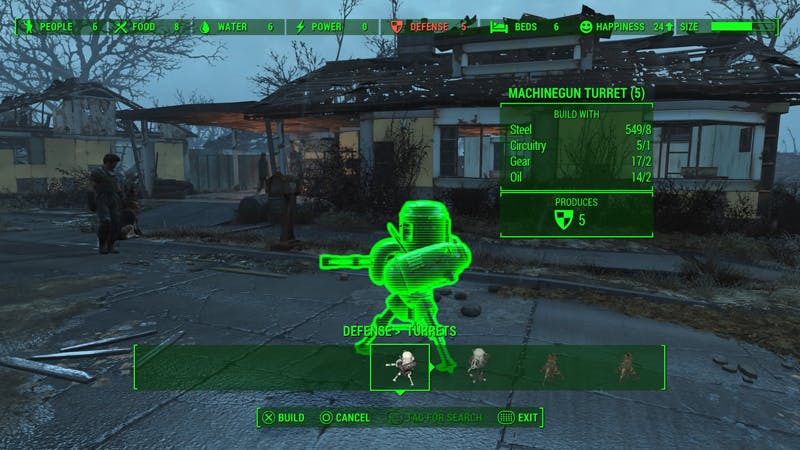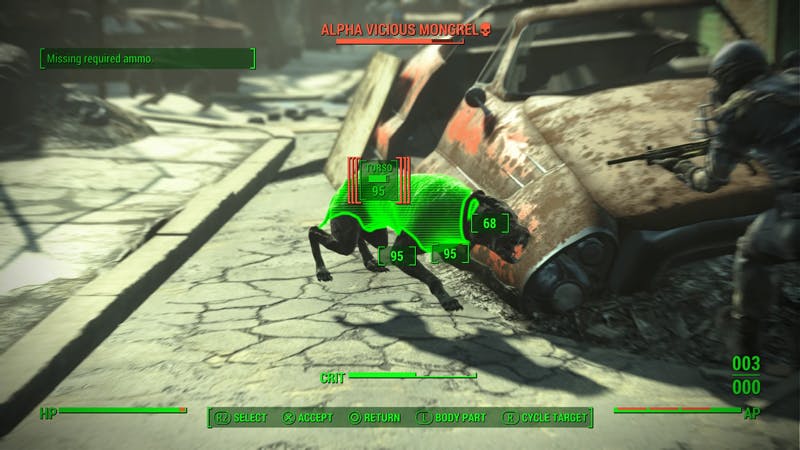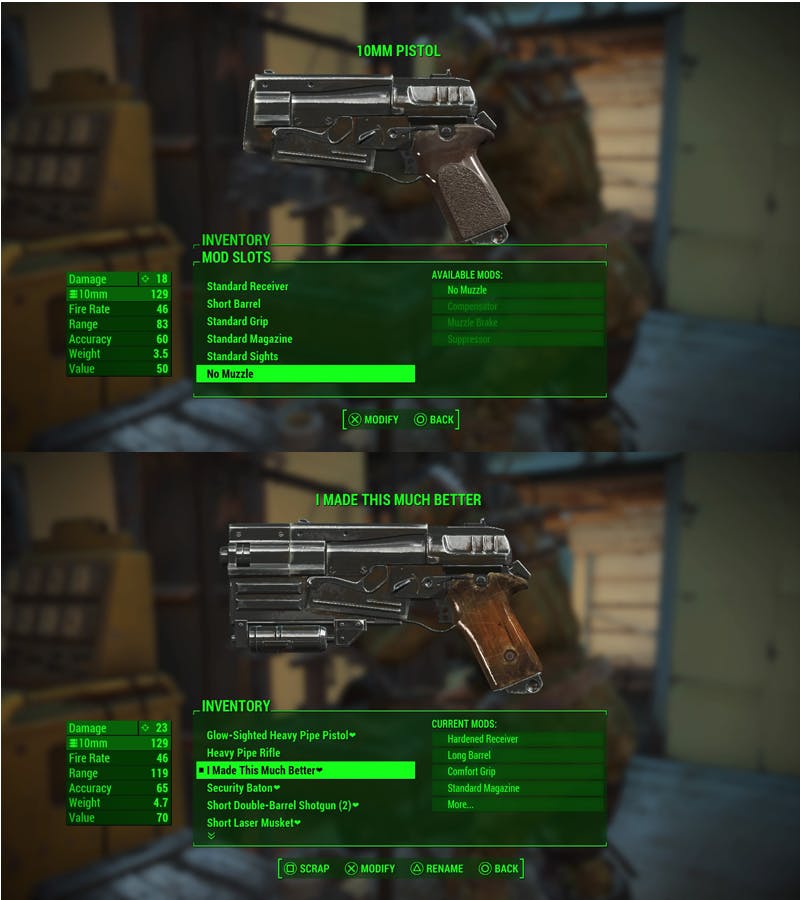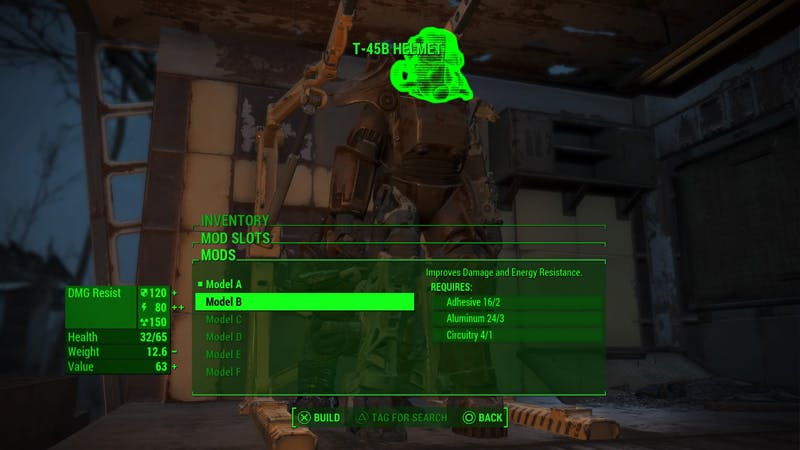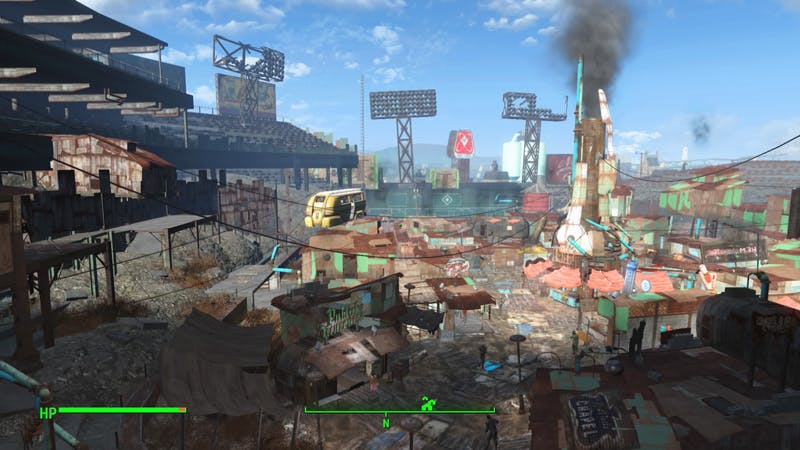Fallout 4 justifies all the hype. It is an improvement on Fallout 3 in every way, and borrows popular systems from Fallout: New Vegas to create the most vibrant Fallout game yet.
Fallout 3 was praised so loudly that you wouldn’t have blamed Bethesda if it had decided to play it safe with Fallout 4 by sticking to the same formula. Instead, very few game elements have gone unchanged.
The writing is better, the characters are more fleshed-out, there’s more variety of environments, combat is more thrilling, and you have substantial opportunity to shape the world rather than simply living there. Fallout 4 has “game of the year” written all over it.
The live-action video introduction tells the story of a post-World War II America where atomic energy fuels everything from cars to domestic robots, and where conflicts over resources are responsible for the nuclear exchange that destroyed everything.
You create your character in pre-war America using a customization system that supports some of the widest diversity of options I’ve seen in a role-playing game. A short prologue immediately contrasts a lovely view of Massachusetts in the fall with the fire-blasted landscape of the Commonwealth 200 years after the apocalypse.
Fallout 4’s overarching story is yet another “find the missing person” quest, this time set in the greater Boston area. The soldiers of the Brotherhood of Steel are still trying to prevent people from using dangerous technologies. Monstrous Super Mutants are still trying to destroy (and threatening to eat) their human creators. And there are raiders and mercenary groups aplenty who will try to kill you on sight.
What’s new to Fallout 4 is The Institute, a scientific cabal whose existence was teased in Fallout 3. The Institute was founded from the remnants of the Commonwealth Institute of Technology, or C.I.T., and specializes in the creation of synthetic humans, or Synths.
In Fallout 3 you had the opportunity to save a Synth who was on the run from its masters at the Institute. In Fallout 4 the Synths are everywhere: combat models that look like Terminators, second-generation prototypes whose rubber skin and yellow eyes are dead giveaways, and late-model androids that are indistinguishable from human beings.
It’s the latter type that has everyone in the Commonwealth paranoid, and tracking down the Institute becomes the ultimate focus of your journey.
When I played Fallout 3, the story felt like a skeleton around which the rest of the game was built. I was much more interested in exploring the wasteland than I was in seeing the end of the game.
The story in Fallout: New Vegas was more interesting. I was more curious about how it would end, but that was still much less important than side-quests and scavenging expeditions and clearing raiders out of ruins.
Fallout 4 flipped these relationships for me. I prioritized pursuing the central narrative over anything else. The fact that your character is voiced gives the story greater visibility, and the new cinematic dialogue option makes your conversations appear more like traditional cutscenes, which also helps tremendously to put the story front and center and make you more invested in your character’s primary quest.
The cast of characters is much more interesting, including all of your companions. Dogmeat, who returns from Fallout 3, is predictably adorable, and his ability to sniff out hidden loot caches and areas of interest is useful. General utility in combat, i.e. whether a companion was a melee or ranged fighter, also guided my choice of traveling companions.
I had more trouble deciding which companion to choose than in any previous Fallout game because I genuinely liked all the companions in Fallout 4. They all have interesting backstories. They make unique comments on the locations you visit. If companions approve of your actions during the game, your relationship with them will deepen. Some of the additional dialogue sequences I unlocked when that happened were really satisfying.
Companions cannot be killed in Fallout 4. If they take too much damage during combat they go down and will stay down until either you run away or clear the area, at which point the companion will get back up and follow you again.
I was surprised by this decision, because the threat of losing companions drove some of the best dramatic moments in Fallout 3 and Fallout: New Vegas. I also know that whenever I lost a companion in either of those games, I immediately reloaded an old save because I wasn’t willing to lose anyone. My guess would be that Bethesda knew most Fallout players did the same and decided to save everyone the hassle of constant reloads.
Old-school RPG fans and fans of the original Fallout games specifically are probably going to hate that companions can’t be killed. Everyone should be thankful for this, however, because the companion AI is terrible. Idiot companions will move ahead of you into rooms while you’re in sneak mode, breaking stealth by attracting attention to you both. There’s also no way to set your companions into passive mode or control the distance at which they follow you, so they’ll constantly start fights that didn’t need to happen. If you want to play a stealth character you may as well either travel alone or limit your companion to being a de facto loot mule by making them stay behind while you sneak into new areas.
The new DJ at Diamond City Radio is hilarious and a massive upgrade from previous radio hosts. Many of the best songs from Fallout 3 are repeated in the music selections of Fallout 4. Early in the game I heard more repeats than fresh tracks. There’s some original music written for the game in Fallout 4, however.
Underneath your adventure is another brilliant soundtrack from Inon Zur. His haunting, subtle compositions for Fallout 4 build off the themes of his score for Fallout 3, and once again they perfectly match the barren beauty of the wasteland.
I live in Boston, so ever since Fallout 4 was announced I’ve been looking forward to seeing how good of a job Bethesda would do in recreating my hometown.
I was answering a radio distress beacon in Cambridge, the town located across the Charles River, to the north of Boston. I finished fending off a pack of Ghouls, former humans driven mad by extreme exposure to radiation, looked up and knew for certain without needing to check the map that I was in Harvard Square, a major landmark in Cambridge.
I recognized the M.I.T. campus at the other end of Massachusetts Avenue, just before I crossed the bridge into the city. I found the Granary Burial Ground off Boston Common. I saw the Trinity Church and realized I was in Copley Square before I even noticed the Boston Public Library behind me.
Some of the names are different, of course, but I absolutely recognized my city and exploring the map was a constant joy. The North End streets are tight, the historically Italian-American neighborhood is dotted with Italian flags. I wasn’t surprised to find a pizza parlor waiting for me.
It’s not just Boston that Bethesda got right, but all the towns around the city. Concord and Lexington bear the unmistakeable hallmarks of New England architecture. Revere and Nahant are beach towns. I haven’t had a chance to explore Salem yet, and I can’t wait to see the witch museum I overheard a character talking about.
At one point I was trying to find my way to the area where my house would be, and my wife pointed at the map and said, “Here, take Route 16 through Everett,” even though no routes or towns are marked on the map. Her directions were still precisely correct. I wish everyone could appreciate as fully as players who are native to Boston the degree to which Bethesda nailed this.
The most substantial change in Fallout 4 is the ability to create settlements. The tutorial section has one quest to teach you the basics of providing shelter, food, water, and defenses. There are numerous side quests that involve clearing out areas for the creation of new settlements, or defending existing settlements.
I suspect that for most players these side quests will be material for keeping busy once the story has been completed. I don’t think your ability to finish the main quest line would suffer for not creating a town. But I also suspect that once you realize how radically the settlement system will affect the way you scavenge for materials you’ll at the very least begin planning early for building settlements later.
Every item in Fallout 4 breaks down into basic components, and items that were junk in Fallout 3 or Fallout: New Vegas can now become vitally important for crafting items. Beaker stands, for example, break down into copper. You need copper to make virtually anything that generates or uses electrical power, so you probably won’t want to sell anything that contains copper as junk to a trader.
Not building at least one settlement would probably make it difficult to organize and store your things because I never discovered anything akin to an apartment in Megaton in Fallout 3 or a room in Novac in Fallout: New Vegas. If you want a place to put your stuff in Fallout 4, you either have to pick a destroyed house and use the cabinets and dressers therein, or build your own place.
Building a settlement was way too fun to ignore during my review playthrough. I only built one, in the area where settlement tutorial took place and where some key NPCs live. I set up a Recruitment Beacon to attract new settlers, and now the town of Sanctuary is fully enclosed in a huge metal wall I put up piece-by-piece.
The town was attacked once and I almost lost a settler, so now the front gate is defended by a gauntlet of machine-gun turrets. I have numerous guard towers set up, and whenever I come home with new armor and weapons I make sure all my guards have the best gear possible. Trader caravans travel through and provide a convenient way to unload gear and make some money.
It got frustrating during my explorations when I ran into settlers and farmers living right out in the open in the Wasteland and couldn’t invite them back to live in my town. Why was I not given the choice to help these idiots who lived behind no walls and no defenses and who were constantly vulnerable to raider attacks when I had a perfectly good, defensible, well-stocked town literally down the road?
Fallout 3 was controversial among old-school RPG fans because while combat still essentially depended on virtual die rolls, the game also behaved like a shooter. Fallout 4 has doubled down on this, to the point where during some gun battles I wondered whether Fallout 4 has become a true shooter/RPG hybrid.
The evolution in combat was most clear whenever I tried to use V.A.T.S., or the Vault-Tec Assisted Targeting System, which allows you target specific body parts and see the odds calculations for scoring a hit. Using V.A.T.S. no longer pauses the game. It does slow time down, but not so much that you can linger while making the decision as to which shots to attempt.
You’ll feel the sense of immediacy the first time you snap into V.A.T.S. while a Mole Rat or a feral dog are poised in mid-air and slowly moving toward you with mouths open, ready to bite.
Much more often than in Fallout 3 or Fallout: New Vegas I snapped right back out of V.A.T.S. because the odds of landing my shots weren’t very good, and I knew I’d be more successful aiming and firing manually. V.A.T.S. is probably more effective at lower difficulties, but I found everything other than Very Hard or Survival difficulty way too easy.
The only times I used V.A.T.S. were when low-level enemies were completely in the open, when I was using an indiscriminate weapon like a missile launcher, or when I wanted to use a high-damage Critical shot (which now has to be triggered manually in V.A.T.S. versus being a random occurrence during the normal course of combat).
You no longer have to choose exclusively between equipping a weapon or equipping explosives, because ordnance is assigned to its own button. All ranged weapons have melee attacks and you can affix bayonets to guns. Sprinting is now part of the game and rapid repositioning saved me dozens of times. All of this made Fallout 4 feel like a proper shooter.
I also played on Survival mode specifically because Bethesda took a page from Fallout: New Vegas and enforced a delay between using a health item like a Stimpack and regenerating hit points. The length of the delay is tied to the difficulty setting.
Even at Normal difficulty you can’t just snap into your inventory, take a stack of Stimpacks to get your health to 100 percent, and then go right back into combat. You always need some break from taking damage to regen health. And the long delay at Very Hard or Survival difficulties means you have to be very smart about how you plan your attack.
I depended on liberal use of combat drugs to survive close-quarters battles like clearing Super Mutants out of buildings in downtown Boston. Many, many times I would take a dose of Psycho to increase my damage, and a hit of Jet that slowed down time for 10 seconds, hear my character hilariously yell “Yeaaaaaaah!” in slow motion, and jump into the fray with my combat shotgun. And it was fantastic every time.
Also borrowed in concept from Fallout: New Vegas is a deep weapon and armor customization system. Each weapon breaks down into six parts that can be mixed and matched to alter damage, effect fire rate, range, stability, and accuracy. The customization system is important generally, but especially when you begin to score Legendary items from enemies.
The harder the difficulty in Fallout 4, the more likely you are to find randomly-generated Legendary enemies in the world. They’re much deadlier than anything else you’ll encounter. When gravely wounded, they’ll often mutate to regain hit points. Mutation also might alter their characteristics. I can’t honestly say, because I put Legendary enemies down with extreme prejudice. I very quickly learned to be terrified of them.
The special gear they drop is worth taking them on. Let’s say you get a Laser Rifle that does 50 percent bonus damage to humans. With Fallout 4’s weapon customization system you can take all the mods you created for a regular, baseline Laser Rifle and slap them onto the Legendary Laser Rifle you looted.
You can also customize armor in Fallout 4. There are a few pieces of clothing that cover the entire body and provide decent protection, but you’re much better off wearing a Vault Suit or combat fatigues and then using six different pieces of armor to create a custom set.
The undergarment itself usually provides some measure of protection and/or stat bonuses, and then you can customize each individual piece of armor to make it lighter and stronger or more resistant to one of the four different types of damage: ballistic, energy, poison, and radiation.
By mixing and matching armor pieces that are customized to resist specific types of damage, you can put together armor sets that provide good protection across the spectrum of weapon types you’ll be exposed to in the wasteland.
You don’t wear Power Armor like clothing in Fallout 4. You ride in it, as if Power Armor were a kind of mech. The armor itself is an exoskeleton upon which you lay armor plates that you can also customize to provide additional stat bonuses or higher levels of protection.
The animation of stepping into and out of a suit of Power Armor is awesome. Your point of view switches to a mech-like HUD where your hit points and action points are tracked on old-school dial gauges. Watching the rain bead up on a Power Armor suit’s visor while exploring the Commonwealth never ceased to be cool.
You are also much more of a badass while wearing Power Armor in Fallout 4 than in the previous two games. Trying to fight in downtown Boston even while wearing some of the best regular armor in the game was a suicide mission—but when I strapped on a suit of Power Armor, I kicked ass and took names.
The trade-off is that Power Armor has to be fueled with Fusion Cores. If your Core runs dry you lose suit functionality like power attacks or the ability to sprint. Diligent scavengers will find plenty of Fusion Cores during explorations, and traders will usually have a Core even if they’re expensive.
If you do run out of power and need to step out of a Power Armor suit, an icon on the map always shows you where you’ve left it. There are Power Armor frames all over the Commonwealth. You’ll usually discover that a few pieces of armor plating are missing, but assembling complete sets of armor plates is easy with just a little exploration of the map.
Power Armor is actually the only gear in Fallout 4 that will ever need repairing. Regular armor pieces and guns do not lose condition. I expect this decision will also be controversial for old-school RPG fans. Then again, you might enjoy not having to find a 10mm pistol for every time you want to make repairs to another 10mm pistol.
Fallout 3’s color palate was defined by omnipresent dull greens, sepia tones, and plain browns. This still largely defines the wasteland outside of the city, but Fallout 4 splashes more color into the mix when you get into the city of Boston. The apocalypse may be bleak, but it doesn’t all have to look washed-out.
The graphics in general are the improvements from Fallout 3 and New Vegas that you’d expect. Everything is much better defined, textures are more detailed, lighting gradients are more subtle, but on consoles especially the graphical eccentricities that define the Fallout and Elder Scrolls games generally can be picked out by mindful observers, particularly when it comes to standard character animations like smoking cigarettes and drinking.
I spent time on the PC, PlayStation 4, and Xbox One versions of Fallout 4, and just as you’d expect, the PC version is clearly superior. This time, however, the focus on story makes the difference between platforms more important. The facial animations during cutscenes on the console versions can be decidedly wooden compared to the same scenes on PC.
Graphics are also the source of most of the bugs that I encountered on the Xbox One version of Fallout 4. There was an entire section of Boston’s North End where the high-res textures failed to load and everything was indistinct and blurry, as if I were seeing it from a vast distance. A few times particle effects failed to load properly, and I saw black boxes where the effects were meant to be drawn.
I highly recommend against trying to change any of your companions’ or an NPC’s undergarments, like a Vault Suit or military fatigues, while that character is wearing armor. Trying to do so crashed Fallout 4 every time I tried it.
Bethesda games, however, are the most obvious demonstration of the fact that the more you love a game, the less any bugs and technical issues are capable of marring your overall experience.
I have spent more than 60 hours in the Xbox One version of the game and don’t feel anywhere close to having tackled most of the content. Fallout 4 could be the only game you buy for the next six months, and you might never get bored. It’s everything that Fallout fans were hoping for. When it comes to game releases in 2015, the best was truly saved for last.
Disclosure: Our Steam, PlayStation 4, and Xbox One review copies of Fallout 4 were provided courtesy of Bethesda. The vast majority of our playthrough was conducted on the Xbox One.
Illustration via Bethesda

